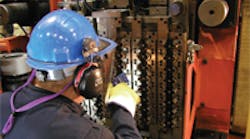In the same way that “motivated sellers” make this the right time to buy a house or a car, an excess of supply and an unprecedented drop in demand have created a rare opportunity in the machine tool market. Machine shops with sound lines of credit are finding an array of highly sophisticated equipment is available from both the new and used markets, according to several industry experts.
But, it’s also a time when manufacturers face the most uncertain economy most of them ever may know, and with banks just beginning to show stability, capital equipment investment in 2009 has been far more tentative than at any time in recent decades.
From May through July, sales of U.S. machine tools and components rose each month, according to a report compiled by the American Machine Tool Distributors’ Association and the Association for Manufacturing Technology. But, those numbers are tempered by the 2009 year-to-date total for manufacturing technology sales of $910.42 million, which shows a 68.3 percent drop from a year ago.
“From everything I’ve seen, many end users are hesitating taking on new capital expenses,” said Frank Peretore, an attorney who focuses on equipment leasing, and who sits on the board of directors for the National Equipment Finance Association. “On the other hand, for those end users that are willing to push forward, it’s been difficult to get funding.”
Part of this reflects the global economy. The landscape for financing of new equipment has changed dramatically in recent years, forcing buyers to seek loans from a banking sector that has consolidated significantly and is far more cautious in its lending habits.
Throughout 2008, Fredon Corp., an Ohio-based supplier of machined parts, invested heavily in new machinery, purchasing a CMM Brown & Sharp CNC coordinate measuring machine, a ZT 2500Y Mori Sieki turning milling center, and an Okuma 500 CNC Horizontal mill with 100 tool changer.
But Fredon’s owner, Roger Sustar, won’t go near the market today.
“Hell no,” said Sustar.
“I’d like to buy right now, but I’m scared.”
According to Sustar, loan rates have changed significantly. Once, manufacturers had been able to finance new purchases at prime rates, often well below 3.25 percent. Now, banks customarily offer the London Inter Bank Offered Rate (LIBOR), which currently hovers below 5.0 percent. But that rate can vary, and does, frequently.
“That changes things tremendously for small businesses,” said Sustar.
To Jack Schron, president of Jergens Corp., a Cleveland-based manufacturer of tooling components, those interest rates shouldn’t scare any company, large or small, with access to capital.
“If you can get financing, from a historical point of view, it’s still pretty darned good,” said Schron. “I compare it with when I bought my first house and got a 12.5 percent mortgage. When I compare it to the interest (rates) we saw then, in relation, today things look great. Even if things bump up, we’re still looking at historical lows.”
In a more cautious lending market, what banks are looking for is a sense of partnership, said Rob Allanson, president of Huntington Equipment Finance. Recently, Huntington Equipment Finance agreed to offer customized financing for customers of Cold Jet, a manufacturer of dry ice blasting equipment.
“Two years ago, there were plenty of financing sources within the machine tool industry,” said Allanson. “There was no requirement that you have a banking relationship. It was basically, ‘Send us your customers, we’ll do the financing and we’ll offer a low rate.’ That’s hurt this industry in this recession because there were so many losses in the business.”
A capital spending report conducted by the Precision Metalforming Association (PMA) for 2009 showed that metalformers would spend an average of $491,755 on equipment in 2009, compared to actual spending of $807,070 in 2008 — a projected decrease of 40 percent.
Repossessions and liquidations of machine tools tripled in the second quarter of 2009, compared to the same timeframe in 2008, according to the NasTrac Quarterly Index (NQI). The study was conducted by Westbury, N.Y.-based Nassau Asset Management, which tracks equipment trends as part of its business providing collections, repossessions and remarketing services to the leasing and finance industry.
“I’ve found a big spike in end users who say, ‘Just come and get the stuff — we’re closing our doors,’ ” said Peretore, “and it’s my impression that the banks are acknowledging the realities of the economy, so long as the customer can give them some comfort level that there’s a reason to hang in there with them.”
While manufacturer bankruptcies and equipment repossessions might be increasing, other signs suggest glimmers of hope for manufacturing, and these signals might indicate more capital equipment investment is on the horizon. According to William Gaskin, president of the Precision Metalforming Association, as factories and facilities — especially those in the automotive industry — begin restarting operations, it will increase the need for more sophisticated equipment.
“Every company is trying not to hire people back,” said Gaskin. “Most companies, at least in this sector, are still down 20, 30 or 40 percent from where they were on an annual basis a year ago. They’re trying to improve their productivity to the extent that they can, hire back the people that they need, and therefore they need to make some capital expenditures. But, it’s really about improving their processes and good equipment can do that.”







